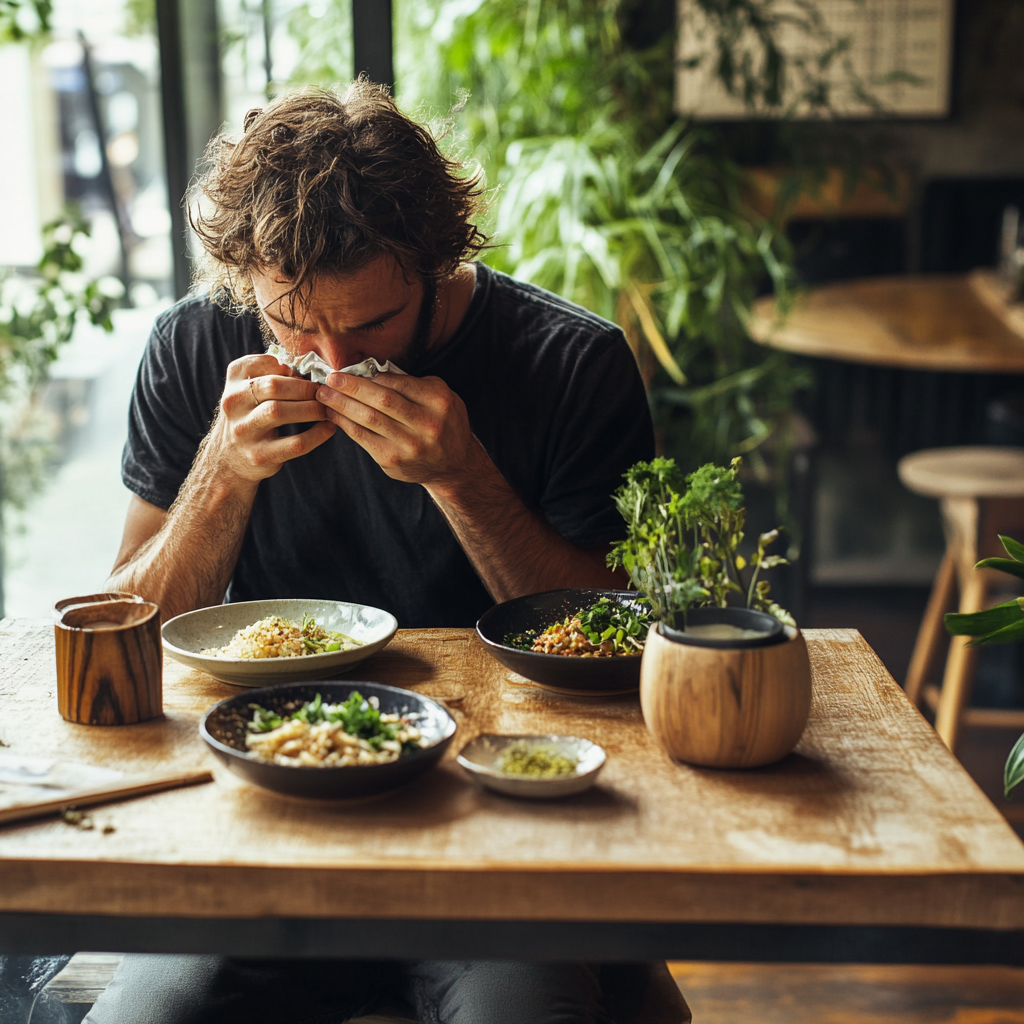2.3 Cross-Contamination Prevention
2.3 Cross-Contamination Prevention

Keeping Food Safe: Avoiding Cross-Contamination
Imagine you’re in the kitchen making a sandwich. You cut raw tofu on a board, then use the same board for slicing tomatoes without cleaning it. Sounds simple, but this can spread bacteria from the tofu to the tomatoes. This is called cross-contamination, and it’s a big deal in kitchens, especially in an open kitchen where guests can see everything!
What is Cross-Contamination?
Cross-contamination happens when germs or allergens spread from one thing to another.
Here’s how it can happen
Raw food touches ready-to-eat food, like a salad.
Tools like knives or cutting boards are used for different tasks without cleaning.
Unwashed hands transfer bacteria or allergens.
Why It’s Dangerous?

Food-poisoning!
Germs like Salmonella or E. coli can make people really sick or even kill them.
Example: A guest eats salad made on a board that wasn’t cleaned properly before cutting the veggies—this could cause food poisoning.
Allergic Reactions: If nuts or soy touch other foods, a guest with allergies could have a serious reaction.
Guest Trust: In an open kitchen, guests watch everything. If they see unsafe practices, they may lose confidence in your food.
How to Prevent Cross-Contamination
Keep Ingredients Separate
Store raw food below ready-to-eat food in the fridge so juices don’t drip.
Label containers for allergen-specific ingredients (like nuts) and store them in separate, sealed containers.
Use the Right Tools
Use color-coded cutting boards to stay organized:
Green: Vegetables
Yellow: Cooked food
Red: Raw proteins (like tofu or tempeh)
Blue: Allergen-specific foods
Clean knives and utensils between tasks to avoid spreading bacteria.
Wash Hands Often
Wash hands before starting any new task and after touching raw food or allergens.
Avoid touching your face or hair while working—it spreads germs!
Keep Surfaces Clean
Wipe counters and cutting boards with sanitizers between tasks.
Use different cloths or paper towels for raw food spills and general cleaning.
Plan Food Prep Smartly
Always prepare allergen-free or ready-to-eat foods first, before raw ingredients.
Use separate prep areas for high-risk foods whenever possible.
Cross-Contamination in an Open Kitchen
Show Guests You Care
Wash your tools, clean your station, and switch utensils for each task—guests notice and appreciate this.
Talk About Safety
If a guest asks about allergens or cleanliness, explain your steps to keep food safe:
Example: “We use separate cutting boards for raw and cooked food to avoid cross-contamination.”
Special Steps for Allergen Safety
Dedicated Tools and Areas
Use separate cutting boards, utensils, and containers for foods with allergens.
Label allergen prep areas clearly.
Prevent Cross-Contact
Wash hands and sanitize surfaces after handling allergens.
Keep allergen particles (like nut crumbs) away from other foods by working in separate areas.
Communicate Clearly
Confirm allergen orders with the guest and team.
Clearly label allergen-specific dishes when serving.
What Happens If Cross-Contamination Occurs?
Mistakes can happen, but here’s what to do:
Act Fast
Throw away any food that might be contaminated.
Stop using the affected workstation and sanitize everything.
Report the Incident
Let your supervisor know right away.
Write down what happened so the team can learn and prevent it in the future.
Team Responsibilities
Stay Trained: Learn about cross-contamination risks and how to avoid them.
Help Each Other: Remind teammates about safety rules and report lapses.
Be Prepared: Follow protocols to keep food safe and guests happy.
Key Takeaway
Keeping food safe is a team effort. By following these simple rules, you can prevent cross-contamination, protect guests, and show everyone that GWF’s kitchen is serious about quality and safety!
Team Accountability and Monitoring

Let me walk you through how GWF ensures teamwork and accountability to keep the kitchen safe and hygienic 🌟✨.
Training and Awareness
Think of training as the foundation of a strong team 💡. Every team member learns about the risks of cross-contamination and how to prevent it. But we make it fun and practical too!
Through role-playing exercises, team members get to act out real-life high-risk scenarios, like handling raw ingredients near ready-to-eat food. It’s like practicing for a big game so everyone knows exactly what to do when it counts 🧼🥗.
Routine Checks
Supervisors are like the hygiene detectives 🕵️♂️, conducting regular spot-checks to make sure everything’s on track.
Using checklists, they monitor tasks like cleaning, sanitizing, and food handling throughout the shift. These checks keep everyone accountable and ensure no detail is missed. It’s about staying proactive, not reactive.
Encouraging a Culture of Vigilance
At GWF, we believe in teamwork and looking out for one another 🤝✨.
Team members are encouraged to remind each other about proper procedures and to speak up if they notice any lapses. This creates a culture where everyone feels responsible for maintaining high standards. It’s not about criticism—it’s about collaboration and care.
Why It Matters
By focusing on training, routine checks, and teamwork, GWF creates a kitchen environment that’s safe, efficient, and professional. These efforts not only protect the food but also build trust among guests and pride within the team 🌱💪.
With everyone playing their part, GWF’s kitchen runs like a well-oiled machine, reflecting our commitment to excellence and sustainability 🌟✨.
Emergency Protocol for Cross-Contamination Events
Let me guide you through how GWF handles emergencies like cross-contamination to keep everyone safe and maintain trust 🌟✨.
Immediate Action
Imagine this: a potential cross-contamination issue happens in the kitchen. What’s the first step? Act fast! 🚨
Discard any food that might be contaminated. No risks, no second guesses—it’s better to be safe than sorry.
Pause service at the affected workstation. This gives the team time to thoroughly clean and sanitize the area before continuing.
This quick action prevents the problem from spreading and shows guests that safety is always the top priority 🧼💡.
Incident Reporting
After taking immediate action, it’s time to report the issue 📋.
Notify the supervisor right away so they can take charge of the situation.
Document what happened in detail, like a detective solving a mystery 🕵️♀️.
Conduct a review to figure out what caused the issue and how to stop it from happening again.
This step isn’t just about fixing the problem—it’s about learning and improving as a team.
Why It Matters
By following these emergency protocols, GWF ensures that food safety is never compromised. Acting quickly, reporting clearly, and learning from incidents protect guests and reinforce GWF’s dedication to excellence 🌱✨.
At GWF, even unexpected challenges become opportunities to prove our professionalism, build trust, and show our commitment to safe, plant-based hospitality 💡🌟.
There are no comments for now.